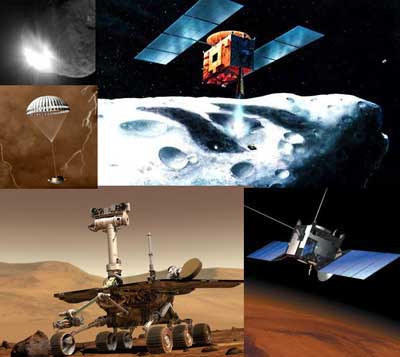2005: The year of solar system discovery
In 2005, scientists continued to explore the mystery of the solar system through spectacular landings and interesting observations .

A composite picture of some astronomical events 2005
2005 opened with the event that the Huygens spacecraft separated from Cassini's mother spacecraft and landed on Saturn's Titan moon. Later, Cassini discovered there seemed to be volcanoes and rain methan on it.
Near the earth, the Deep Impact spacecraft launched a copper bullet into the comet Tempel 1, creating a cloud of dust and ice. Because of the appearance of this cloud and a camera that is not working properly, the spacecraft cannot see the wormhole created on the surface of the comet.
Interesting observations
Astronomers are also very happy to discover a celestial body that is probably the 10th planet in our solar system. The planet is named Xena, bigger than Pluto. In late 2005, it was the group who discovered Xena was observing a moon around Xena and they named it Gabrielle.
Another large object, belonging to the Kuiper belt and about the size of about 70% of Pluto, was also discovered this year. However, this information needs further confirmation.
Another uncertain information regarding Apophis asteroids.
Observations at the end of 2004 show that this 300m-diameter object is capable of plunging into the earth in 2029. Subsequent observations in 2005 indicate that a collision in 2029 is unlikely.
However, the fact that Apophis rushed across the earth could make this astronomical trajectory change so much that it could plunge into the earth in 2034 or later.
And yet, in Mars orbit, the European Space Agency's Mars Express has finally deployed Marsis after months of delay. This antenna found signs of liquid water in a deep pit, buried, created by meteors.
The spacecraft also found evidence of sea ice on Mars.
Sample work
NASA's Spirit and Opportunity robots, still moving on Mars, observe dust vortices, meteorites, meteor showers and analyze sulfur-rich rocks.
They have also overcome many technical obstacles. Opportunity gets bogged down in the sand and it takes five weeks to get out of this trap. Spirit's robotic arm stopped working for a short time. Both robots will celebrate their second birthday in January 2006.
However, 2005 also marked a number of failures: Esa's Cryosat satellite and Planet Society's Cosmos 1 solar sail, which were not put into orbit because of a malfunctioning rocket.
The Japanese asteroid model spacecraft encountered a series of problems. Its Minerva robot is missing due to being deployed in the wrong direction. Efforts to land on asteroids and collect samples seem to be unsuccessful. Japan plans to bring the Hayabusa spacecraft back to Earth in 2010.
Minh Son
- New discovery of the solar system like the solar system
- NASA press conference announced the secret of the solar system
- Discovery of the baby solar system record
- Evidence of the 9th planet of the Solar System
- The Solar System and NASA's great discoveries
- Discover the oldest solar system outside the solar system
- Will the Solar System have 9 planets again thanks to this new discovery?
- NASA is about to announce the world of the solar system in the solar system
- Beautiful photo from the Solar System
- Explore the atmospheric atmospheres of the solar system
- Space Science: The order of 8 (or 9) planets in the Solar System
- Discover the youngest planet outside the solar system
 Van Allen's belt and evidence that the Apollo 11 mission to the Moon was myth
Van Allen's belt and evidence that the Apollo 11 mission to the Moon was myth The levels of civilization in the universe (Kardashev scale)
The levels of civilization in the universe (Kardashev scale) Today Mars, the sun and the Earth are aligned
Today Mars, the sun and the Earth are aligned The Amazon owner announced a secret plan to build a space base for thousands of people
The Amazon owner announced a secret plan to build a space base for thousands of people How long does it take to reach another star system besides the Solar System?
How long does it take to reach another star system besides the Solar System?  How long is the flight to the Moon?
How long is the flight to the Moon?  Humans reach for the stars in 2024
Humans reach for the stars in 2024  NASA postpones manned moon mission due to unusual incident
NASA postpones manned moon mission due to unusual incident  NASA's Farthest Flying Spacecraft Is Dying
NASA's Farthest Flying Spacecraft Is Dying  China sends 'Moon bricks' into space
China sends 'Moon bricks' into space 